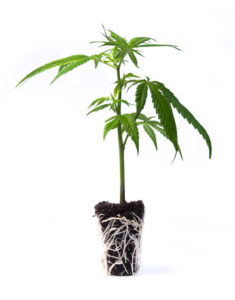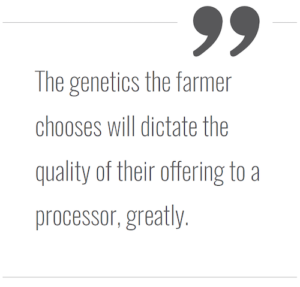Consider Risks and Rewards When Selecting Hemp Genetics
This year — 2020 — is going to be a defining year for cannabinoid hemp production in the United States. For some states this will be the third year farming hemp and for others, for example Georgia, Texas and Florida, they are hoping this will be their first year.
Not only do we have states who are slow to hand out permits, which causes a slew of challenges in itself within the crop production supply chain this late in spring, but we also have varying types of THC compliance and time to harvest regulation scenarios in each state. These scenarios should dictate genetic selection for the season.
The reason we still have states differing in regulation, despite the recently released Federal Regulations, is due to the Federal Regulations allowing states that grew in 2019 to continue under their Pilot Program for one additional year. This permission is fantastic for farmers in these states to continue to grow as they have been for one or two years. These farmers will continue to grow cultivars, which potentially can bring a higher margin for one more year while allowing time to decide how to approach the new Federal Regulations.
 THC Compliance
THC Compliance
There are multiple scenarios regarding THC compliance and harvesting windows, but let’s walk through four of them. For example, your state may have chosen to follow the USDA’s newest interim rulings, which cause you to stay in compliance at or under 0.3% Total THC while trying to not only stay compliant but also harvesting in a 15-day test to harvest window. Or you may have the opportunity to go one more year under your state’s pilot program which enables you to surpass 0.3% Total THC (in some cases) and only stay in compliance at or under 0.3% Delta 9 THC.
You may also be just lucky enough to not only follow Delta 9 regulations but also take advantage of a 30-day test to harvest window. These regulations are flip-flopped between one another per state and this should be your first factor to consider when determining what genetics you will either offer as liners or grow in the field for biomass in your state. The devil is in the details, let me explain why…
There are huge differences in the genetics that can be grown without risk in “Delta 9” states versus Total THC states. For example, we would recommend anyone in a Delta 9 state to grow “Southern OG,” which has tested as high as 22% CBD and yields are extremely high (~5lbs/plant if allowed to go full term). But this cultivar also has a total THC of around 0.7% at full term, yet it stays compliant under the Delta 9 regulations. Though if harvested very early, it would be “compliant” but the yields would be terrible. This is why it’s so important to truly understand the genetics you are growing.

The regulations are only one hurdle for farmers and greenhouse growers, another is determining if your genetic supplier can actually deliver on their product claims. At The Hemp Mine, between our seven cultivars offered this season, we would recommend different cultivars per regulation scenario to enable the farmer to properly maximize their CBD%/lb of biomass (i.e., revenue potential) while staying in compliance per state. At the end of the day, or rather at the end of the season, what dictates a farmer’s success, regarding compliance, is when they harvest during the flowering process.
When discussing genetic offerings with a breeding company, don’t just take their word for it. When a breeder says their genetics are USDA compliant, what the heck does this mean? From the breeder perspective this means that the COA (certificate of analysis) they shared with you is compliant, meaning they harvested their crop early enough to stay in compliance in order to generate that COA. This does not mean the genetics are compliant by default but rather they were harvested at the appropriate time to stay under the THC ceiling. Breeders should say, our genetics “can be” compliant with USDA regulations based on when you harvest. There are outliers to this, like our CBG-focused cultivar, Janet’s G, that can be grow to maturity and harvested at 12% CBG/lb and only 0.15% Total THC. Be careful about this and question these vendors.
Seeds Versus Clones
Seeds versus Clones? This is a constant back and forth. Yes, in most cases a clone costs more compared to a single seed (up front), but does this actually reflect the cost of the genetics over the whole season to the farmer? Many genetic decisions are being made on capital upfront and not considering the instability of hemp seed genetics in general and what this actually costs during production and thus the lack of value during the sale of the final product.
 What matters to the farmer and what matters to the young plant greenhouse grower can be different but in a way, the same — production and revenue predictability. The farmer needs a product they can sell to a processor. This product is mg/acres in the form of biomass (pounds of harvested plant material) and should have a value proposition itself. This proposition is based on crop growth consistency in yield and potency per pound. A processor cares about consistent biomass, not seed, not inconsistency per batch of CBD, but consistency which dictates the cost of production for the processor through extraction efficiency per kilogram.
What matters to the farmer and what matters to the young plant greenhouse grower can be different but in a way, the same — production and revenue predictability. The farmer needs a product they can sell to a processor. This product is mg/acres in the form of biomass (pounds of harvested plant material) and should have a value proposition itself. This proposition is based on crop growth consistency in yield and potency per pound. A processor cares about consistent biomass, not seed, not inconsistency per batch of CBD, but consistency which dictates the cost of production for the processor through extraction efficiency per kilogram.
The genetics the farmer chooses will dictate the quality of their offering to a processor, greatly. From a greenhouse grower perspective, who is used to either growing ornamental crops or vegetable crops, they care about efficiency and thus production consistency (cost/ft2/yr). However, if a greenhouse grower only chooses seed because it is easier to propagate, does not need near as much labor nor greenhouse space allocated to it, they are possibly putting the farmer at risk not knowing the genetics’ performance after shipment. When making decisions only based on greenhouse efficiency, this could ruin the farmer. Clones are more predictable from stable and trialed genetics. For example, The Hemp Mine has trialed all of our cultivars in the South over the past two years indoors and outdoors at scale for disease resistance, crop to crop growth consistency, genetic stability, flower initiation photoperiod requirements, potency and now even postharvest shipping success of hemp URCs (unrooted cuttings).
Seed genetics are all over the map and come with a latent cost throughout production due to a lack of breeding and thus genetic stability — predictability. You think it is risky getting into hemp without a buyer for your product yet determined — it is a 10-fold higher risk when choosing the wrong genetics.
Photos courtesy of The Hemp Mine








